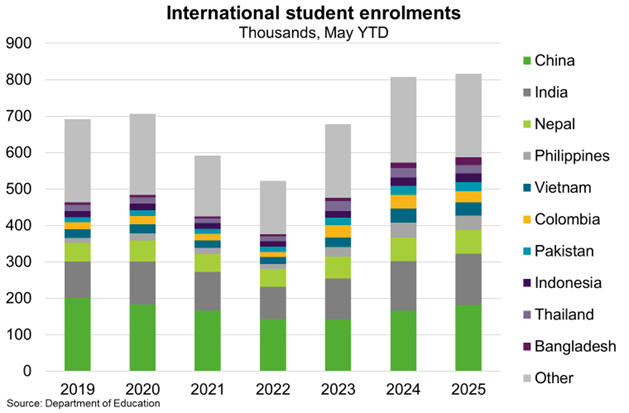© Export Finance Australia
The views expressed in World Risk Developments represent those of Export Finance Australia at the time of publication and are subject to change. They do not represent the views of the Australian Government. The information in this report is published for general information only and does not comprise advice or a recommendation of any kind. While Export Finance Australia endeavours to ensure this information is accurate and current at the time of publication, Export Finance Australia makes no representation or warranty as to its reliability, accuracy or completeness. To the maximum extent permitted by law, Export Finance Australia will not be liable to you or any other person for any loss or damage suffered or incurred by any person arising from any act, or failure to act, on the basis of any information or opinions contained in this report.
Australia—Education exports resilient amid demand headwinds
Education is Australia’s fourth largest category of export (behind iron ore, coal and natural gas), reaching a record $52 billion in 2024 or 41% of total services exports. The number of international student enrolments remains high, at 817,000 over the year to May, a 1% increase on 2024 (and an 18% increase on 2019). Emerging Asia comprises three quarters of international enrolments, with students from China and India the largest cohorts (Chart). Following pent-up demand caused by closed borders in 2020 and 2021, continued strong demand reflects global population growth, Australia’s popularity as an international student destination, a relatively competitive Australian dollar and relatively resilient household disposable incomes in Asia. Indeed, emerging Asian countries are expected to contribute two thirds of global economic growth this year, as they did last year. China and India will remain among the world’s fastest growing major economies, expanding 4.8% and 6.4% this year respectively, according to latest IMF forecasts.
However, growth in the number of international students onshore has slowed on the back of tighter visa rules, as expected. Since the peak in FY2023, the number of student visas lodged has fallen 28% to 427,000 in FY2025, while the number of student visas granted has fallen 36% to 372,000. Similarly, international student commencements declined by 15% over the year to May on the same period in 2024, to 241,000. Australia has tightened processing standards and increased requirements for applicants, including via proof of savings and English language requirements. Visa application fees have been increased and a cap on how many hours international students can work has been reintroduced. That said, temporary student visa arrivals have generally exceeded departures in recent months, according to Australian Bureau of Statistics data, suggesting the number of students onshore continues to increase.

